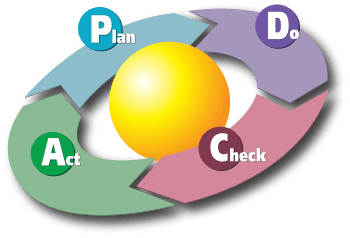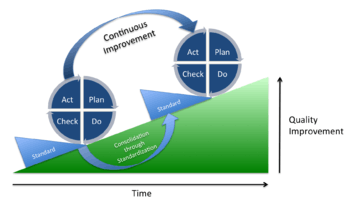PDCA
PDCA (plan–do–check–act or plan–do–check–adjust) is an iterative four-step management method used in business for the control and continual improvement of processes and products.[1] It is also known as the Deming circle/cycle/wheel, the Shewhart cycle, the control circle/cycle, or plan–do–study–act (PDSA). Another version of this PDCA cycle is OPDCA.[2] The added "O" stands for observation or as some versions say: "Observe the current condition." This emphasis on observation and current condition has currency with the literature on lean manufacturing and the Toyota Production System.[3] The PDCA cycle, with Ishikawa’s changes, can be traced back to S. Mizuno of the Tokyo Institute of Technology in 1959.[4]
Meaning


Plan
The planning phase involves assessing a current process, or a new process, and figuring out how it can be improved upon. Knowing what types of outputs are desired helps to develop a plan to fix the process. It is often easier to plan smaller changes during this phase of the plan so that they can be easily monitored and the outputs are more predictable.
Do
The do phase allows the plan from the previous step to be enacted. Small changes are usually tested, and data is gathered to see how effective the change is.
Check
During the check phase, the data and results gathered from the do phase are evaluated. Data is compared to the expected outcomes to see any similarities and differences. The testing process is also evaluated to see if there were any changes from the original test created during the planning phase. If the data is placed in a chart it can make it easier to see any trends if the PDCA cycle is conducted multiple times. This helps to see what changes work better than others, and if said changes can be improved as well.
Example: Gap analysis, or Appraisals
Act
If the check phase shows that the plan phase which was implemented in do phase is an improvement to the prior standard (baseline), then that becomes the new standard (baseline) for how the organization should act going forward (new standards are thus said to be enACTed). Instead, if the check phase shows that the plan phase which was implemented in do phase is not an improvement, then the existing standard (baseline) will remain in place. In either case, if the check phase showed something different than expected (whether better or worse), then there is some more learning to be done... and that will suggest potential future PDCA cycles. Note that some who teach PDCA assert that the act phase involves making adjustments or corrective actions, but generally it would be counter to PDCA thinking to propose and decide upon alternative changes without using a proper plan phase, or to make them the new standard (baseline) without going through do and check steps.
Adjust
The adjust phase is the alternative version of the act phase. Once PDCA has been run multiple times, the process generally has enough information for it to be considered a new standard. This is usually completed in the act phase. The adjust phase allows the process to continue to be monitored after the changes have been implemented and fix them accordingly. Doing this lets the PDCA cycle truly be for continuous improvement instead of changing a process and letting it become inefficient again.
About
PDCA was made popular by W. Edwards Deming, who is considered by many to be the father of modern quality control; however, he always referred to it as the "Shewhart cycle". Later in Deming's career, he modified PDCA to "Plan, Do, Study, Act" (PDSA) because he felt that "check" emphasized inspection over analysis.[6] The PDSA cycle was used to create the model of know-how transfer process,[7] and other models.[8]
The concept of PDCA is based on the scientific method, as developed from the work of Francis Bacon (Novum Organum, 1620). The scientific method can be written as "hypothesis–experiment–evaluation" or as "plan–do–check". Walter A. Shewhart described manufacture under "control"—under statistical control—as a three-step process of specification, production, and inspection.[9]:45 He also specifically related this to the scientific method of hypothesis, experiment, and evaluation. Shewhart says that the statistician "must help to change the demand [for goods] by showing [...] how to close up the tolerance range and to improve the quality of goods."[9]:48 Clearly, Shewhart intended the analyst to take action based on the conclusions of the evaluation. According to Deming, during his lectures in Japan in the early 1950s, the Japanese participants shortened the steps to the now traditional plan, do, check, act.[4] Deming preferred plan, do, study, act because "study" has connotations in English closer to Shewhart's intent than "check".[10]

A fundamental principle of the scientific method and PDCA is iteration—once a hypothesis is confirmed (or negated), executing the cycle again will extend the knowledge further. Repeating the PDCA cycle can bring its users closer to the goal, usually a perfect operation and output.[10]
Another fundamental function of PDCA is the "hygienic" separation of each phase, for if not properly separated measurements of effects due to various simultaneous actions (causes) risk becoming confounded.[11]
PDCA (and other forms of scientific problem solving) is also known as a system for developing critical thinking. At Toyota this is also known as "Building people before building cars".[12] Toyota and other lean manufacturing companies propose that an engaged, problem-solving workforce using PDCA in a culture of critical thinking is better able to innovate and stay ahead of the competition through rigorous problem solving and the subsequent innovations.[12]
Deming continually emphasized iterating towards an improved system, hence PDCA should be repeatedly implemented in spirals of increasing knowledge of the system that converge on the ultimate goal, each cycle closer than the previous. One can envision an open coil spring, with each loop being one cycle of the scientific method, and each complete cycle indicating an increase in our knowledge of the system under study. This approach is based on the belief that our knowledge and skills are limited, but improving. Especially at the start of a project, key information may not be known; the PDCA—scientific method—provides feedback to justify guesses (hypotheses) and increase knowledge. Rather than enter "analysis paralysis" to get it perfect the first time, it is better to be approximately right than exactly wrong. With improved knowledge, one may choose to refine or alter the goal (ideal state). The aim of the PDCA cycle is to bring its users closer to whatever goal they choose.[3]:160
When PDCA is used for complex projects or products with a certain controversy, checking with external stakeholders should happen before the Do stage, since changes to projects and products that are already in detailed design can be costly; this is also seen as Plan-Check-Do-Act.
Rate of change, that is, rate of improvement, is a key competitive factor in today's world. PDCA allows for major "jumps" in performance ("breakthroughs" often desired in a Western approach), as well as kaizen (frequent small improvements). In the United States a PDCA approach is usually associated with a sizable project involving numerous people's time, and thus managers want to see large "breakthrough" improvements to justify the effort expended. However, the scientific method and PDCA apply to all sorts of projects and improvement activities.[3]:76
See also
References
- ↑ Tague, Nancy R. (2005) [1995]. "Plan–Do–Study–Act cycle". The quality toolbox (2nd ed.). Milwaukee: ASQ Quality Press. pp. 390–392. ISBN 0873896394. OCLC 57251077. Retrieved 2017-10-21.
- ↑ Foresight University, The Foresight Guide, Shewhart's Learning and Deming's Quality Cycle,
- 1 2 3 Rother, Mike (2010). Toyota kata: managing people for improvement, adaptiveness, and superior results. New York: McGraw-Hill. ISBN 0071635238. OCLC 318409119.
- 1 2 Deming, W. Edwards (1986). Out of the crisis. Cambridge, MA: Massachusetts Institute of Technology, Center for Advanced Engineering Study. p. 88. ISBN 0911379010. OCLC 13126265.
- ↑ "Taking the first step with PDCA". 2 February 2009. Retrieved 17 March 2011.
- ↑ Aguayo, Rafael (1990). Dr. Deming: the American who taught the Japanese about quality. A Lyle Stuart book. Secaucus, NJ: Carol Pub. Group. p. 76. ISBN 0818405198. OCLC 22347078. Also published by Simon & Schuster, 1991.
- ↑ Dubickis, Mikus; Gaile-Sarkane, Elīna (December 2017). "Transfer of know-how based on learning outcomes for development of open innovation". Journal of Open Innovation: Technology, Market, and Complexity. 3 (1): 4. doi:10.1186/s40852-017-0053-4.
- ↑ Dubberly, Hugh (2008) [2004]. "How do you design?: a compendium of models". dubberly.com. Retrieved 2017-10-21.
- 1 2 Shewhart, Walter Andrew (1986) [1939]. Statistical method from the viewpoint of quality control. New York: Dover. ISBN 0486652327. OCLC 13822053. Reprint. Originally published: Washington, DC: Graduate School of the Department of Agriculture, 1939.
- 1 2 Moen, Ronald; Norman, Clifford. "Evolution of the PDCA cycle" (PDF). westga.edu. Paper delivered to the Asian Network for Quality Conference in Tokyo on September 17, 2009. Retrieved 1 October 2011.
- ↑ Berengueres, José (2007). The Toyota production system re-contextualized. Tokyo: José Berengueres. p. 74. ISBN 1847534775. OCLC 906982187.
- 1 2 Liker, Jeffrey K. (2004). The Toyota way: 14 management principles from the world's greatest manufacturer. New York: McGraw-Hill. ISBN 0071392319. OCLC 54005437.
Further reading
| Wikimedia Commons has media related to PDCA. |
- Kolesar, Peter J. (2005) [1994]. "What Deming told the Japanese in 1950". In Wood, John C.; Wood, Michael C. W. Edwards Deming: critical evaluations in business and management. 2. New York: Routledge. pp. 87–107. ISBN 9780415323888. OCLC 55738077. Reprint. Originally published: Quality Management Journal 2(1) (1994): 9–24.
- Langley, Gerald J.; Moen, Ronald D.; Nolan, Kevin M.; Nolan, Thomas W.; Norman, Clifford L.; Provost, Lloyd P. (2009) [1996]. The improvement guide: a practical approach to enhancing organizational performance (2nd ed.). San Francisco: Jossey-Bass. ISBN 9780470192412. OCLC 236325893.
- Shewhart, Walter Andrew (1980) [1931]. Economic control of quality of manufactured product. Milwaukee: American Society for Quality. ISBN 0873890760. OCLC 7543940. 50th anniversary commemorative reissue. Originally published: New York: Van Nostrand, 1931.